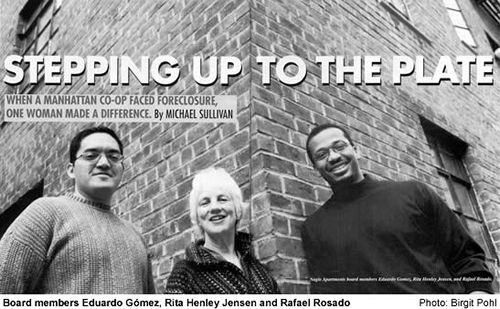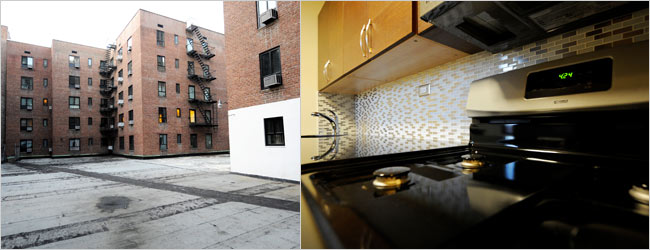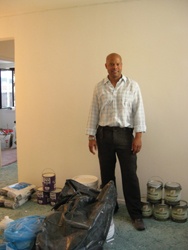When a Manhattan co-op faced foreclosure, one woman made a difference.
By Michael Sullivan
Reprinted, with permission, from Habitat, vol. 21, no. 175 (January 2002).
Walking around the grounds of Nagle Apartments, a 111-unit cooperative complex in the Fort Tryon area, it is hard to believe that the co-op was once on the edge of foreclosure, facing multiple lawsuits simultaneously. There is a new children’s playground, a new community room, and a beautiful garden. Beyond that, there is a tangible sense of hope and community among the residents.
Walk back a decade and the picture was entirely different. Firmly in the grasp of the sponsor, the co-op was living a financial nightmare. Units sold at dirt-cheap prices and the atmosphere seemed downright dangerous. How would you like to be awakened by an ax coming through your wall when a neighbor decided to make some unsanctioned renovations? Or have pigeons nesting in your apartment?
The root of cooperatives is cooperation. With it, properties grow and flourish. They develop into a community. Without it, the needed nutrients aren’t there and the property stagnates and eventually begins to wither. That was what was happening at Nagle Apartments. It was slowly being choked to death.
The story of Nagle Apartments’ renaissance illustrates the power one voice can have and how that grows exponentially when it gains support. It is a lesson in community-building and perseverance, of how one co-op was reborn after near-death.
Using Power Wisely
In 1987, Rita Henley Jensen, who had to sell her place on Morningside Drive as part of a divorce settlement, was looking for the cheapest apartment she could find in a relatively trouble-free neighborhood. She had also just started a job as a reporter for the National Law Journal. Jensen “settled” for a sixth-floor apartment at Nagle Apartments, a three-building cooperative complex near The Cloisters—the price was right and the unit provided a view of trees and the nearby park.
Having spent time at a daily newspaper covering the government beat, Jensen became curious after a short time about how the co-op ran its affairs. She felt she had a pretty firm grasp of how things should be running, so she attended an annual meeting in 1988 to see how the board operated. It wasn’t long before her hand shot up.
“Where’s the annual report?” she asked.
“Oh, it’s not done yet,” was the reply.
Shocked, Jensen asked another question, a “softball,” she now calls it, something that the board should have been able to answer without much difficulty. She doesn’t remember what it actually was, but she remembers the reaction.
“I was stonewalled,” she recalls. “They couldn’t give me an answer. This was a big investment on my part and I wanted to understand what was going on.”
Jensen walked away troubled by that meeting. At the next year’s gathering, she was shocked once more. A board member gave a talk on how much of the property’s budget was consumed by mortgage payments. The figure spurred Jensen into action. She joined the board in 1989. “This was a building that had a heavy investor and sponsor presence, so it wasn’t difficult to get on the board,” she explains. “We hadn’t had a competitive election ever—one of our afflictions.”

Using her investigative talents, Jensen began unearthing the mortgage mess. It turned out that the sponsor held the mortgage and that there were provisions in the offering plan that required the co-op pay an exorbitant interest rate if it failed to refinance. With owner-occupancy in a horrid state and the mortgage coming due in 1992, there seemed little chance Nagle Apartments would succeed in refinancing. In addition, Jensen discovered, the sponsor had ceased making his maintenance payments, while the co-op still made mortgage payments to him.
Not one to hold her tongue or forego the use of strong language when needed, Jensen told the other board members simply, “This is bull——. He doesn’t pay us, we don’t pay him.”
“But what if he forecloses?” the other members asked. He won’t, she assured them. The board had long been afraid of acting against the sponsor in what Jensen says was “corruption by passivity.” By not doing anything or even attempting to rectify the problem, the board was costing shareholders money.
The board, at last, took its first stand . . . and the checks started coming in. At least from the sponsor. As the market started to sour, other investors would begin to cease paying maintenance and default.
The Larger Goals
Encouraged by the success, Jensen took a look at another of the property’s concurrent issues, a below-market, 20-year garage lease held by a garage operator. The original lease had expired in 1985, but the board had extended it another 15 years. Curiously, none of the members in 1987 knew about the renewal and because of this tried to evict the operator. In the litigation that followed, the operator produced the signed lease extension to the board’s surprise and the board was stuck in a “no-win” lawsuit.
Jensen sums up their condition: “We’ve got no reserves, we’re in a no-win litigation, the mortgage is coming due, investor ownership is a problem. It’s bad.” The board’s previous philosophy—trust our professionals, it will all work out—needed some revising. Maybe something more current, like The X-Files’ catchphrase: “Trust No One.”
The first victim of the new philosophy was the property’s attorney. When a settlement regarding a contractual dispute with the sponsor was delivered via a handwritten fax with no details regarding dates or cash reimbursements, Jensen stood up again and said, “No.”
“But this is the best we can do,” another board member said.
“Then let’s not do it,” Jensen replied. The board disagreed and approved it anyway.
Not deterred by the lack of support, Jensen stayed on the board and became president in 1991. She kept her eye on the attorney, though.
Go Tell It to the Mountain
Now came another lesson for the battling board, which can be summed up this way: “Go tell it on the mountain. If you don’t get the answer you want or like, keep searching. You may be wrong, but you may also be right.”
Explains Jensen: “It’s like a doctor. You should trust them, but you should also ask about the prescription they give you. Your professionals will give you the classic, cautious answer. If you’re a wealthy co-op then you should probably take it. But if you have your back up against the wall, the classic, cautious response may be inappropriate. It might be good legal advice, but it may not be appropriate.”
In the process of covering some of New York City’s biggest law firms for her job, Jensen had a chance to often write about the deals the partners were working out. Of keen interest to her was the ability of companies to restructure their debt. In her capacity now as board president she turned around and wondered why they couldn’t do the same thing.
“You just can’t,” the co-op’s attorney told her.
“Why not? I don’t like this one,” she said.
“You can’t.”
“Well, I want to.”
Frustrated with the bickering, Jensen gave the lawyer a test. Much like her initiation to the board, she asked him a softball question: “What zone are we in?” The answer cost her $400—the attorney said that he needed to send an associate over and make copies of maps and other material. His response cost him his job with Nagle Apartments. An attorney out to rack up billable hours at their expense was not what they needed.
Nagle Apartments’ current attorney, Theresa Racht, a partner with Rosen & Livingston, says that, legally, the late 1980s and early 1990s were a different time from 2001. Key cases didn’t exist yet that clarified how the relationship would work between sponsor and building. So boards were hamstrung. They were left having to rely on professionals who were blazing the trail.
That doesn’t mean, however, that boards had to follow or should follow blindly. “Boards really need to listen to their instincts and ask for back-up information,” advises Racht. “[They should] ask if the theory the attorney is using has been tried anywhere else and what the results were. Tell them: ‘Give me examples of where this issue has come up. Explain this to me more.’ Look at the time being spent on your building and try to get a sense of what they are spending it on. If you are getting six hours billed for ‘research,’ find out what the research involved. Find out what the procedures are. Get a full understanding. There may be a cheaper way to do it.”
Frustrated by events, Jensen took up the cause with the sponsor at every opportunity she could. She began attending public forums wherever she could and testifying about the building’s plight with its sponsor, accusing the attorney general of abandoning co-ops by not regulating them.
“It was a scam. You could sell the building at whatever price to shareholders. You held the mortgage and then sold apartments to investors so that it could never really be a co-op. Then you could sell three or four units to someone who drove a taxi, for instance. Clearly they were underwater. And they are renting to really young people. So all this cash was getting drained and we’re faced with an inability to make it a co-op or find other financing. We were held captive by whatever terms they could dictate.”
And captives they remained. Or so the sponsors thought.
Connections
Getting something accomplished can be partly about connections, says Jensen, a prize-winning writer. You never know to who you might be speaking or who they know. “As a reporter, this is what you do, right? On whatever story I was working on I kept knocking on doors until I got what I needed to get. You call people cold. You know how the levers of power work and how to meet powerful people. I knew that I needed the powerful people in this community to understand what was going on.
“Co-op voters vote. Political leaders are aware of this and I bet they know how specific buildings vote. That’s important. You have to know that these people are employees of the community and I think they are there because they like helping people. They can’t always help you, but if they can, they will.”
In November 1994, the sponsors sat down with Jensen and discussed the mortgage and an extra $1,000 a month that the owners would have to pay them. Jensen stood up, put her coat on and walked out.
Things seemed hopeless until a chance conversation at a bar meeting. An attorney mentioned to Jensen that he had heard that one of the sponsors was in bankruptcy court. Upon further follow-up, it was determined that this was true and that he was the sole proprietor of the building. “Bingo!” shouted Jensen. The property thus fell under the control of the bankruptcy trustee.
At the time this began, the Community Development Corporation (CDC) decided to make funds available to co-ops so that they could buy out their sponsors. The writer picked up her pen and wrote. Detailing their building’s difficulties, Jensen wrote a letter to CDC and Nagle Apartments eventually became the first building to receive funds, $1 million. The outstanding mortgage was $1.95 million. The board then got into negotiations with the bankruptcy trustee and bought their mortgage for about 50 cents on the dollar.
Again, things seemed to be looking up for Nagle Apartments. But when the filing happened relating to the deal, the two sponsors came dashing in, crying for the deal to be halted. Their defense in court? “They said that when they had informed us that one of them was the sole proprietor that he had just been saying it, that it wasn’t true,” explains Jensen. “It was actually a complicated partnership and this other guy that we haven’t heard from in years, he owns part of it, they say.”
So, rather than making a quick deal, Nagle Apartments was once more looking at litigation. And the professionals were again telling the board that they wouldn’t win. The partnership probably did exist, so all the sponsors would be guilty of would be perpetrating a fraud on the board. To make matters worse, the sponsors shortly afterward went to state court and put the property into receivership—the board had stopped making mortgage payments because they weren’t really sure who they were paying anymore. The judge sided with the sponsors, thus robbing the board of income to run the building. “Now, we’re screwed,” Jensen recalls thinking. But, she notes happily, her board stuck by her.
“Rita had put the lion’s share of effort into everything during this time and the board really looked to her for guidance and opinions,” observes Robert Kleinbardt, a board member and investor. “Most everyone followed her.”
“She was a natural leader,” agrees Frank Castillo, a first-time board member who moved into Nagle Apartments in 1995. “She was really keyed into all that was going on and kept up-to-date on laws and management issues. We gravitated toward her. We also had open meetings and encouraged people to come and participate. The best way to make changes, we told them, was to get involved.”
Jensen filed disciplinary proceedings against both the sponsors, who were attorneys. They, in turn, filed a contempt citation against Jensen. As if that weren’t enough, they further alleged that the co-op’s attorney should not represent Jensen because it would be a conflict of interest. So she represented herself . . . and won.
The rollercoaster wasn’t ready to settle yet, though. Back in court on the foreclosure action, the judge informed Jensen that there wasn’t any defense against such an action. Flabbergasted but unflappable, Jensen and the co-op’s bankruptcy attorney came up with a strategy, one part of which was to show that there was cause, $55,000 in legal fees worth of cause. Mounds of paperwork were filed.
Like every other dealing, the course of this suit would wind up and down and knot itself in all sorts of ways. At one moment, the paperwork would all turn up missing. In the next, Jensen would be bumping into a friend of the judge’s, who offered to step in and help her. The judge, with an additional set of paperwork also gone missing, at this point seemed to tire of the insanity and sent the case to mediation.
The Truth Is Out There
Nagle Apartments ended up receiving in the settlement $100,000 cash from the sponsor, $100,000 off the face value of the mortgage, and a new 10-year, lower-interest rate mortgage that would allow the co-op to prepay at a rate of $25,000 per year and eventually, after seven years, be allowed to find other financing and prepay the entire amount. In addition, any units that came up for sale could not be sold to investors.
“As homeowners we wanted to pay down our debt. It really bothered me that, after 14 years, we still owed the same amount of money after paying roughly $14,000 a month,” notes Jensen. “We were renting money that we never had.”
At the time this agreement was signed in February 1997, there were 31 owner-occupants in the buildings. The turnaround after this began almost immediately. All during the “bad years,” the board had continued to buy apartments, grabbing one for just $1,500. Following the settlement, the board began selling apartments for $20,000, $30,000, and up. Loans were still difficult to procure, so the board offered purchase money mortgages.
Not long after this, Jensen attended a cocktail party at Columbia University where she met a man from Chase Bank who was in charge of their Community Bank program. The program, not yet underway at that point, was designed to make loans available to purchasers in co-ops with fewer than 50 percent owner-occupancy if the bank believed that their loans could or would lead to 50 percent owner occupancy. Even though, at 30 percent, Nagle Apartments did not qualify, Jensen got a business card anyway.
When Jensen approached the Chase representative, she says, she didn’t know that it was he who she would be looking for. She was simply targeting people who might be able to help her and making connections. Eventually, she thought, someone would point her in the right direction.
In the year following her meeting with the Chase representative, the board pushed hard at trying to get above 40 percent owner-occupancy, at which point they felt they could approach Chase again. By 1999, after instituting a sublet policy, the co-op was close enough to qualify and Chase began making loans. For a few years, these were the only loans available to purchasers.
One of the key factors that led to increased interest in purchasing was a website put together by board member Eduardo Gomez. Complete with floor plans for all the units and useful information for both buyers and owners, the website, www.naborsapts.org, brought immediate results. (Not the least of which was that building policies were now available for viewing and consulting.)
“I saw the website and thought that there had to be something wrong with the price,” recalls Quenby Miller, who bought in 1999 and almost immediately got on the board. “There was so much information there, so I kept looking and researching. But I couldn’t find anything else like it.”
Miller, a newcomer to home ownership as well as to co-op life and board service, relied on Jensen to teach her the ropes. “You have to listen a lot in the beginning,” Miller observes. She also caught some of Jensen’s commitment and, even after she left the board, she stayed involved with different committees.
“We have a very diverse community and a lot of personalities,” she observes. “The key, I think, was that we kept our minds on the final product and managed to find a way for all our styles to fit together.”
“It could have been a powder keg,” adds Mary Hack, the current manager of the property. “But the board treated everyone with respect and responded to their needs quickly. They genuinely cared that everyone got a professional, courteous, and intelligent response to their concerns.”
The Future
One question that hasn’t been asked is where was the manager during all this time? Jensen says they’ve been through about five companies now and finally have a good one in Mary Hack, of Blue Woods Management. During the troublesome times, the managers seemed to offer nothing in the way of advice, but something in the way of lining their pockets. Marvin Gold Management was one among the many; it went out of business when its principal pled guilty to corruption charges.
A board, having learned its lessons, can have its professionals doing what they are supposed to be doing. Jensen, gladly, says they’ve finally gotten there. “We’re at a point now where people are taking the management of the building away from me and I think that this is terrific. We’ve grown up now. For a while it felt like it was mine and only mine. It was my obsession to work this out. Then others bought into this, into the idea of a community and responsibility.”
Others now plan the parties at the buildings. Others are taking control of negotiating the new garage lease, expiring in February 2002. Others are looking into window replacement. And the reserve fund, so long empty? It’s $50,000 and rising. The two sponsors are down to 13 apartments. Whereas a two-bedroom apartment sold for about $20,000 after the settlement, one sold recently for $119,000.
As always, Jensen is keeping herself busy. In June 2000, she launched Women’s E-News, a news service company that provides articles on women’s issues to media outlets. Ironically, the lessons she has taken out of her board service have proved vital in helping her forward her other goals.
Buildings survive when people step up to the plate, she concludes. And whether or not things work out, you’ll leave a better person with more skills than when you entered. “A lot of what I learned through this whole process I’m taking with me to this startup. To develop something from scratch takes a lot of confidence and I had a lot more of it at the end of this business. I could walk into a bank and talk to them about a million-dollar deal. No problem. I can play with the big boys.”





